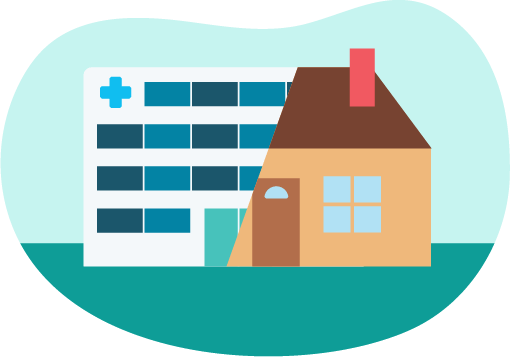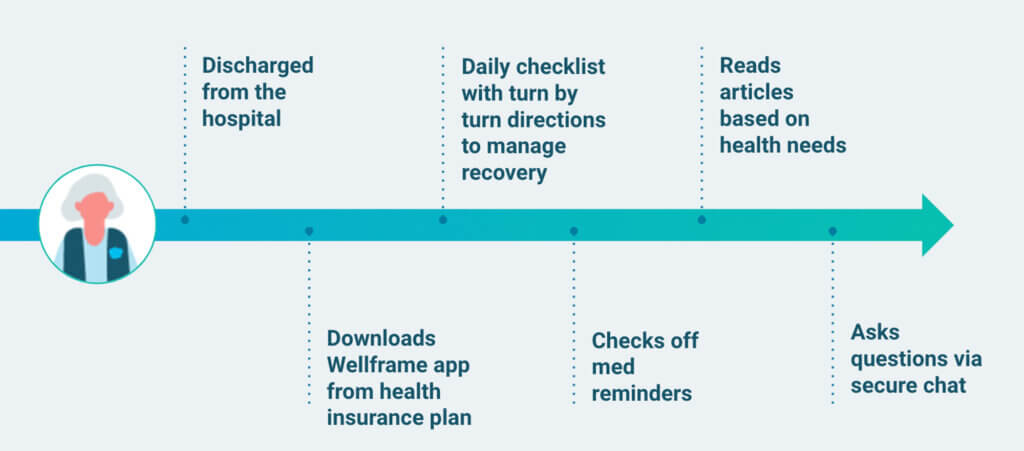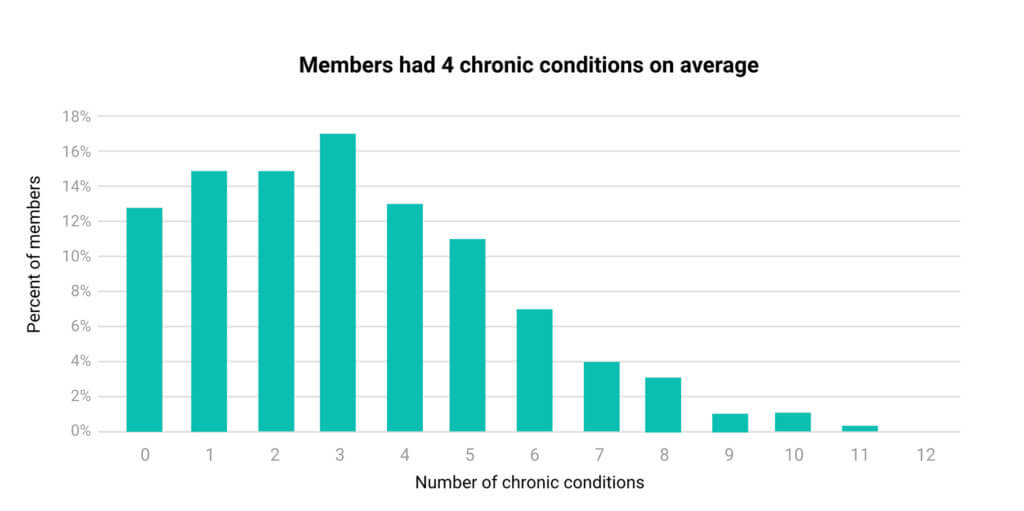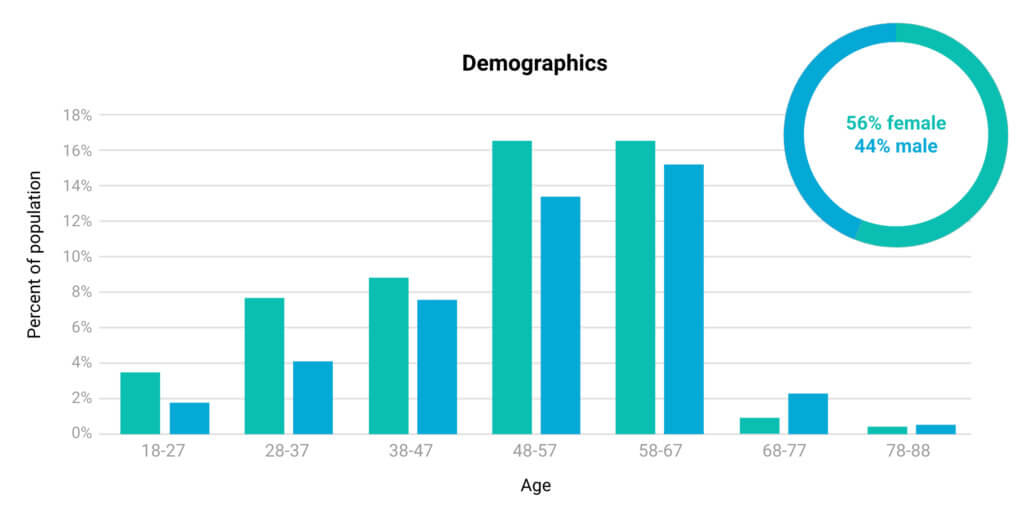CASE STUDY
Digital health improves care transitions for members with multimorbidities
Improve utilization and reduce readmissions with digital health

Executive summary
- Digital health interventions reduced readmissions by 33% for patients with multimorbidities
- Seniors benefited most from digital interventions, with a 29% reduction in ER usage
- Members who completed the most tasks had a 36% reduction in readmissions compared to the control group
Challenges to effective care transitions
Being discharged from the hospital comes with many challenges. From remembering medications to sticking to your doctor’s instructions. And managing multiple conditions during this time can be overwhelming. Care transitions are essential to maintaining health at home. Digital health management empowers providers to support members and improve care transitions—leading to fewer readmissions and complications.
Wellframe data scientists examined claims data and platform-generated data from a large sample size of adult Wellframe users. These members were admitted to the hospital for medical or surgical procedures between January of 2017 and January 2020. By applying a new peer-reviewed evaluation methodology, our data scientists assessed the impact of a digital intervention via rigorous comparison to a control group. This allowed them to minimize the effects of factors that often bias similar studies.
Data scientists assessed the impact of digital health management on:
- Coordinated care efforts
- Timely follow-up after discharge
- Feelings of unpreparedness in patients and caregivers
- Social determinants of health
Breaking down barriers to care transitions
The study found that the Wellframe digital health intervention did significantly improve care transitions for those with multimorbidities. Study participants lived with four chronic conditions, on average.
After participants were discharged, the test group downloaded the Wellframe digital health management app. Using the app, patients were able to:
- Use a personalized daily checklist to stay on track with their recovery
- Receive and check off medication reminders
- Read articles based on their specific health needs
- Ask care managers questions through a secure messaging function
Data scientists pulled insights from member data generated by user activity in the Wellframe app. Some examples include digital assessments, physical activity tracking, articles read, and others.
In addition, about 25% of participants enrolled in another care program at the same time as the care transitions program. The most common concurrent programs were chronic disease, wellness, behavioral health, and oncology. Allowing participants to enroll in multiple programs allowed care teams to address participants’ health needs holistically.
The results
Researchers used four metrics to assess the efficacy of digital interventions on care transitions.
Subsequent admissions, or readmission rates, is a negative outcome that shows how many participants were admitted to a hospital within 30 days of discharge. Increased ER utilization indicates that participants experienced symptoms severe enough to seek urgent medical attention.
Physical medicine utilization is a positive outcome, as it shows participants are taking advantage of their care teams and health benefits. Finally, increased office visit utilization shows that participants are seeing their care providers and staying on track with their care management plan.
The study highlighted three key findings based on these metrics:
- Digital health interventions drive better outcomes
- Higher engagement correlates with better outcomes
- Seniors saw the greatest benefits from digital health
1. Digital health interventions helped improve care transitions
The study found that members who used the Wellframe app demonstrated a 33% reduction in subsequent inpatient admissions over 30 days. Even over 90 days, inpatient admissions were 18% lower for app users than the control group.
App users also reported a 25% reduction in ER visits over 30 days compared to non-users. Participants who used the app reported 11% lower ER episodes over 90 days compared to the control group.
Digital care management tools allow care providers to meet members where they are, and access relevant information on their own schedules. The app used in the study also connects users to their own care managers, who could answer questions through a secure chat feature or schedule phone calls.

2. Higher digital engagement correlates to better outcomes
It’s not always enough to have access to digital health management. Participants who used the app most often reported greater improvements than those who used it inconsistently.
Study participants who completed the greatest volume of tasks reported 36% fewer subsequent admissions than those who used the app less frequently. Similarly, those who completed the most tasks reported 32% fewer ER visits than other participants.
The takeaway? Offering multiple points of entry for digital care management makes it more likely that members will engage. Users can also choose which resources and tools work best for their lifestyles—such as articles, surveys, and reminders. In addition, offering clear “next steps” and action items makes it easier for users to understand how to manage their own health.
3. Seniors saw the greatest benefits from digital health
Do you think older Americans aren’t using mobile devices? Think again. In this study, seniors benefited most from using a digital health management tool.
Inpatient readmissions were 40% lower for seniors (aged 60+) who used digital health interventions. ER utilization was 29% lower for seniors who used the app during the study.
Access to digital health management meant that seniors could improve their own health literacy by reading relevant, clinically reviewed articles. The app also empowered seniors to take charge of their own health through setting medication and appointment reminders. Using a digital health platform makes it easier for older Americans (and their families or caretakers) to stay on the same page and improve care transitions.
Key statistics
122
Average member touchpoints over their first 90 days33%
Reduction in readmissions due to digital health interventions29%
Reduction in ER usage for Seniors using digital health36%
Readmission reduction for members who completed the most tasksStudy demographics overview


Digital health management can improve care transitions, but what else can it help your plan accomplish?
Sign up for a demo today and see how partnering with Wellframe can empower your plan to improve member relationships.